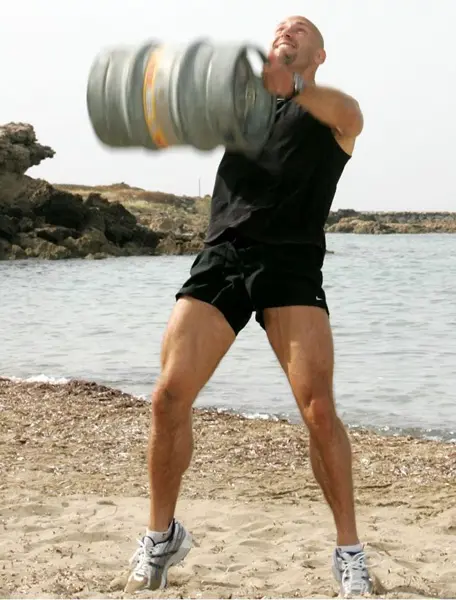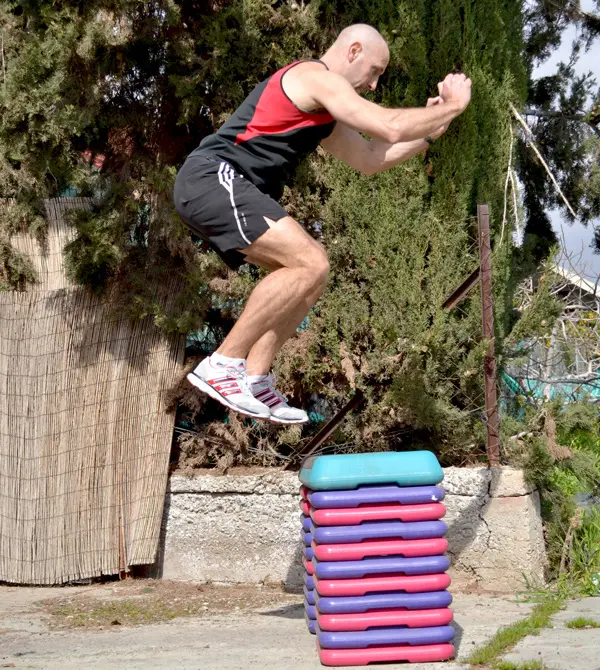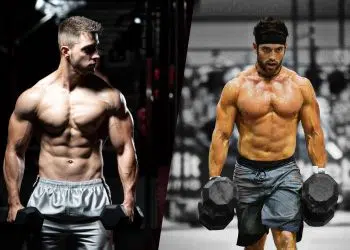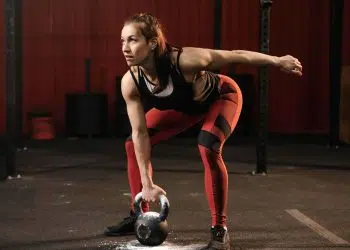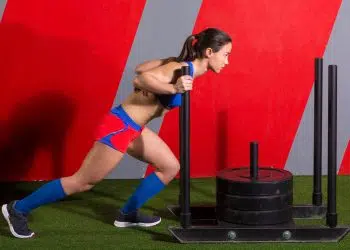Have you ever dreamed of dunking a basketball? Or spiking the ball in volleyball? Well, we’ve got good news and bad news for you!
The bad news is that your ultimate jumping height is limited by your genetics, specifically your ratio of explosive fast-twitch muscle to slow-twitch muscle fibers. If you find long-distance running easier than banging out a set of heavy squats, you are probably slow-twitch dominant, and that means you’ll never be able to soar like an eagle and get huge airtime. Sorry ‘bout that!
The good news is that even the most endurance-fiber dominant person can still increase their vertical leap. You might never dunk, but you can always improve your jumping height.
But what if you don’t play sports? Should you still care about your vertical jump? The answer is yes!
Jumping is a feat of muscle power, which is your ability to generate force quickly. Muscle power is a useful physical trait that makes many activities more manageable, from getting out of a chair to walking up a hill or flight of stairs to setting a new squat or deadlift personal best.
Muscle power creates momentum, and momentum is your friend. Compare standing up slowly to standing up fast. Fast is easier because a) it takes less time, and b) that explosive start pushes you past the usual sticking points so you can get up more easily. The same is true for lifting a heavy object off the floor. It’s a whole lot easier with some extra momentum.
Level Up Your Fitness: Join our 💪 strong community in Fitness Volt Newsletter. Get daily inspiration, expert-backed workouts, nutrition tips, the latest in strength sports, and the support you need to reach your goals. Subscribe for free!
In short, whether you are a baller, a runner, or just want to develop some useful all-round muscle power, working on your vert is a good use of your training time.
Here are 10 of the best exercises to improve your vertical jump.
The Best Exercises to Improve your Vertical Jump
The following exercises are listed in approximate order of difficulty, so start at the top of the list and work your way down when you are ready to progress.
Most importantly, when doing these exercises, focus on maximal effort rather than cranking out dozens of reps. After all, jumping is a high-intensity activity that only takes a few seconds and is usually only done a couple of times taking a break.
Because of this, your sets should also be very short – no more than 10-15 seconds in duration. This will taget the fast-twitch muscle fibers responsible for generating power, which are the ones you need to train if you want to improve your leap.
If you notice that your movement speed or jumping height is starting to decrease, it’s time to end your set. Rest fully between sets (2-3 minutes) to maintain the quality of your workout.
Finally, because these exercises involve maximum effort, you should make sure you are warmed up and ready to go before starting your workout. This will reduce your risk of injury and also increase exercise performance.
Do a few minutes of light cardio, followed by some dynamic stretches and joint mobility exercises. Finish off your warm-up with a couple of low-intensity sets of the exercises you are about to do.
1. Kettlebell Swings
Kettlebell swings might seem like an odd exercise choice when training to improve your vertical jump. After all, jumping uses your quads, and swings are more of a glute exercise, right?
But, the truth is that jumping involves as much hip extension as it does knee extension, and swings are a very powerful hip extension exercise. A lot of people have weak glutes and hamstrings, and spending long periods sat down makes this problem worse.
If you want to improve your vertical jump, you need to wake up and strengthen your glutes and hamstrings, and swings are one of the best ways to do it. However, you will need to go heavy to fully engage these crucial muscles.
Read also 12 Kettlebell Exercises For Hypertrophy, Strength and Function
2. Medicine Ball Overhead Throws
If kettlebell swings have a disadvantage, it is that you’ll probably have to decelerate your kettlebell at the mid-point and end of each rep. Needless to say, that’s not usually something you do during a jump.
One way around this problem is to release the kettlebell at the top of your rep, turning a swing into a throw. Needless to say, most gyms will frown at such behavior, and your fellow gym users will end up running for cover whenever you show up to work out.
Medicine ball overhead throws are a much more gym-friendly exercise, although you will still need to do them with care and caution. Maybe this one is best done outside!
How to do it:
- Hold your medicine ball in both hands and stand with your feet about shoulder-width apart, knees slightly bent.
- Without rounding your back, bend over and down and hold the ball between your knees.
- Extend your knees and hips as powerfully as possible and, keeping your arms relatively straight, throw the ball up and over your head.
- Walk to retrieve it and repeat.
No medicine ball, or just want an exercise that’s a bit more badass? Try throwing a keg, rock, or sandbag instead. But, make sure you consider your surroundings and your own safety when using even a medicine ball as it’ll hurt if it lands on your head!
3. CAT Barbell Back Squats
CAT stands for compensatory acceleration training and is a useful method for turning almost any strength training exercise into a power exercise. Squats work all of the same muscles used in jumping, but they are more of a “slow strength” exercise.
Because of the law of exercise specificity, if you squat slow, you’ll learn to move slow too. Subsequently, regular barbell squats are not all that useful for increasing your vertical jump.
But, using the CAT method involves much more purposeful acceleration, and that is an effective way to improve jumping power.
How to do it:
- Set up for barbell back squats as usual – bar resting on your traps, core braced, and feet about shoulder-width apart. Use about 50% of your 1RM.
- Push your hips back, bend your knees and descend until your thighs are about parallel to the floor. Do not round your lower back.
- Stand up as fast as you can. Imagine you are trying to jump but, because of the load on your back, your feet won’t leave the floor.
- Reset your core and repeat.
- Don’t do more than 3-5 reps.
4. Box jumps
One of the best ways to improve your vertical jump is to include more vertical jumps in your workouts. However, while jumping is a relatively safe activity, landing is not, and the higher you jump, the more impact and stress you put on your joints, ligaments, tendons, and muscles. This stress is cumulative and can lead to wear, tear, and chronic injuries. There is a reason that so many elite basketball players have bad knees at a young age!
Box jumps are a useful power exercise because they minimize your impact on landing. This means they’re safer and less fatiguing while still being a beneficial exercise.
How to do it:
Level Up Your Fitness: Join our 💪 strong community in Fitness Volt Newsletter. Get daily inspiration, expert-backed workouts, nutrition tips, the latest in strength sports, and the support you need to reach your goals. Subscribe for free!
- Set up a sturdy, knee-high platform. Make sure it won’t tip over when you land on it. Stand a couple of feet back from it. Descend into a quarter squat and swing your arms behind you.
- Without pausing, swing your arms and jump forward and up onto the box. Land on slightly bent knees for stability and to absorb the shock of landing.
- Step down, reset, and repeat.
- Don’t let your ego get in the way of a good workout. If you have to tuck your knees into your chin to complete your jump, your platform is too high. Instead, make sure you can land on your box in a shallow squat. This is much safer and also gives a more realistic indicator of your jump height.
Read more about Box Jump here.
5. Deep Water Squat Jumps
This is another low-impact but high-value jumping exercise. While you will need a pool to do this one, the rewards will make your efforts worthwhile. Not only will you be able to jump with maximum effort against not one but two sources of external resistance, you won’t have to worry about landing impact, so it’s a very safe exercise.
However, if you do this one at a public pool, please let the duty lifeguard know what you are up to; otherwise, they may think you need rescuing.
How to do it:
- Swim out into water that’s a little deeper than you are tall. Hold a kettlebell with both hands or a dumbbell in each hand. Sink down to the bottom of the pool and land with your feet about shoulder-width apart.
- Using the weight(s) for ballast, squat down and then extend your legs as hard as you can. Drive upward, so your head clears the water. Take a breath.
- Sink back down and repeat.
- For safety, do this exercise close to the side of the pool. Leave the weight on the pool floor between sets so you can swim to the side and rest unencumbered between sets.
6. Bulgarian Split Squat Jumps
Bulgarian split squats are a great muscle building exercise that can be modified to increase jumping power instead. With this exercise, your front leg does more work, which provides some useful overload.
Also, because it’s a unilateral exercise, Bulgarian split squats are an excellent way to identify and fix left to right strength imbalances. Finally, not all vertical jumps are two-footed, so it makes sense to include at least some single leg exercises in your lower body power workouts.
How to do it:
- Stand with your back to a knee-high bench or step. Bend one leg and place your foot on the top. Hop forward and into a split stance.
- Bend your legs and lower your rear knee down to about an inch above the floor. Try to keep your front shin vertical.
- Extend your front leg as powerfully as you can and drive up and off the floor into a hop.
- Land with a slightly bent knee and repeat.
- Take a rest and then repeat on the opposite leg.
7. Squat Jumps
What goes up must come down, and it’s time to add a full-force landing to your vertical jump training. Landing is not only an unavoidable part of jumping; it’s also an excellent way to expose your muscles to more stress, making them stronger and more powerful in the process.
Only attempt this exercise if you can squat properly and do not have any lower body aches or pains that the unavoidable impact could make worse. Also, take care if you are overweight as that will add to the stress on your joints.
How to do it:
- Stand with your feet shoulder-width apart. Descend into a quarter-depth squat and swing your arms behind you.
- Using your arms for added momentum, jump up into the air as high as you can.
- Land on slightly bent knees, reset your position, and repeat. There should be a short but definite pause between reps.
8. Squat Jumps with Weights
Once you have mastered bodyweight-only squat jumps, you should be ready to add some extra weight. Start with 5-10% of your body weight and increase gradually from there. You can hold dumbbells, wear a weighted vest (probably the best option), or rest and hold a barbell on your shoulders. You can also do goblet squat jumps using a kettlebell.
Do your squat jumps as before but pay even more attention to proper spine alignment and core bracing, and also try to land as softly as you can.
It goes without saying that squat jumps with weights are an advanced lower body power exercise and should only be attempted by experienced, well-conditioned exercisers.
9. The Olympic Lifts
Weightlifting is often described as jumping with weights in your hands. However, instead of leaping up into the air, the force generated by your legs is transferred into the barbell, which, in turn, travels upward. It’s no coincidence that a lot of weightlifters have impressive vertical jumps despite not doing any specific jump training!
There are two Olympic lifts – the clean and jerk, and the snatch. While the full versions, which include a deep squat, can be hard to learn, the “power” versions use a simpler, shorter range of motion and are much more accessible.
You can read more about the Olympic lifts in this article. For a more straightforward but equally effective exercise that will improve your vertical jump, why not give power cleans a try?
10. Plyometrics
Plyometrics is one of the best ways to develop a bigger vertical jump. It’s also one of the most intense training methods, which is why it’s at the end of our list. Many coaches believe that you should be able to back squat around 150% of your body weight before trying plyometrics. That’s because, when you land, those are the sorts of forces your body will need to withstand.
This is probably a little over-cautious, as you can make most plyometric exercises easier and less stressful. That said, this guideline does reinforce that this is a challenging training method that should only be used by well-conditioned exercisers.
In simple terms, plyometrics are jumping exercises where you do your utmost to turn your landing into another jump all-but instantly. For example, while doing squat jumps, instead of pausing between reps, you land and then try to explode into another rep with no pause between efforts.
With all plyometric exercises, the aim of the game is to minimize ground contact time. One way to do this is to imagine the ground is red hot and that you don’t want to touch it for longer than absolutely necessary. Imagining a bouncing ball is another useful cue.
Good plyometric exercises for boosting vertical jump height include:
- Squat jumps (no pause between reps)
- Hurdle jumps (jumping over a series of barriers)
- Depth jumps (jumping off a raised surface to increase landing force)
- Hops for height (do the same number of reps on each leg)
- Hurdle hops
- Depth hops
Because of the high impact nature of plyometrics, only attempt these exercises if you have healthy, stable knees, hips, ankles, and feet. This is not a workout for people who are overweight, pregnant, or have lower body joint or back pain.
Sample workout to improve your vertical jump
While you could just add 1-3 of these exercises to your existing leg workout, you’ll get better results if you follow a more structured plan. This workout contains a mixture of power and strength exercises.
Why not all power exercises?
Because power training is neurologically taxing and can take a lot out of your nervous system as well as your muscles and joints. Doing too much can lead to fatigue and even overtraining.
Do this workout once or twice per week, after a thorough warm-up. The exercises are listed in order of difficulty, from hardest/most technical to easiest, so make sure you do them in that order.
| Exercise | Sets | Reps | Recovery | |
| 1 | Power cleans | 5 | 3 | 3 minutes |
| 2 | Dumbbell squat jumps | 4 | 4 | 3 minutes |
| 3 | CAT back squats | 3 | 5 | 2 minutes |
| 4 | Side lunges | 3 | 8 reps per leg | 90n seconds |
| 5 | Leg extensions | 2 | 10 | 60 seconds |
| 6 | Leg curls | 2 | 10 | 60 seconds |
| 7 | Cable twists | 3 | 12 reps per side | 60 seconds |
The Best Exercises to Improve your Vertical Jump – Wrapping Up
Even if you don’t care about the height of your vertical jump, power exercises like overhead throws and box jumps still deserve to be a part of your lower body training.
Why? Because they are FUN!
Most strength exercises have to be done slowly and deliberately, ensuring you keep the tension on the target muscles throughout each and every rep. Power exercises must be done explosively, and that makes a refreshing change from the heavy but slow training that most lifters focus on. Plus, power exercises will make you more athletic too.
So, whether you want to dunk like a boss or just want to add a new dimension to your leg workouts, you can use these ten exercises to do it.

